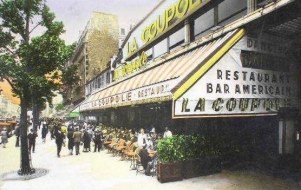Famous region of Paris on left side of the Seine. When Paris was the world's center it was besides Montmartre the place for artists and Bohemians. The mountain of Parnassus.... so here reigns Apollo and on the other side Dionysus? Right: St.Denis is somewhere behind Montmartre, isn't it?
Among others we could find here (or in near St.Germain des Prés) Giacometti, de Beauvoir, Sartre, Kiki and her Man Ray etc....
They had two favourite cafés: Le Dôme and La Coupole

We searched cemetery there for Modigliani's grave, but we found Marie Laurencin's. But then we rushed towards a Brasserie.
The most visited Cafés: Closerie des Lilas, Café de Versailles, Café du Dôme and Café de la Rotonde. From about 1900 there was a family-like artist colony, all kind of creative people and of course the tourists sat on the terasses of the cafés. But when the worldwide economic crisis broke out in 1929, this ended over night.
Artists living in Montparnasse:
Kiki
During the 12.century the citizens of Paris began to get out of the defended Ile de la Citét, the settled on both sides of the river. Quickly the right side was established as economic and "bourgeouis" town, whereas the left side belonged mainly to the church and showed only villages, churches and cloisters. It was soon called "Université" because of its many schools. The most famous was the "Sorbonne" (founded in 1275 as second university of Europe - after Bologna). In the south there was a green hill. There the students performed their poems, sonn the place was called "Mons Parnassus".
From the beginnig of the 19. century the biggest attraction of the "rive gauche" was dance. Everybody came to the big Bals: La Grande Chaumière and the Closerie des Lilas (Bal Bullier). The dancers were the rich men from the other side with their lovers, the students with worker maidens, called "grisettes" and curious couples from everywhere. The Boulevard de Montparnasse showed many attractions to them, and the ambiance was not as stiff as in the right side of the Seine.
Comments (0)
You don't have permission to comment on this page.